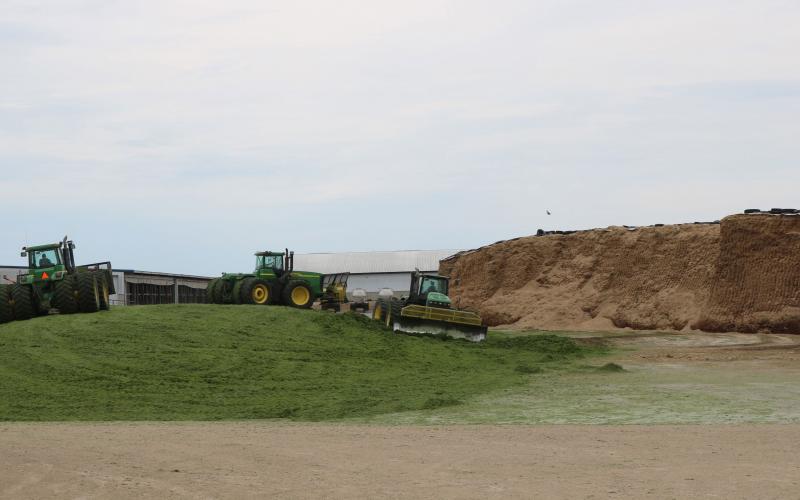A key advantage to using commodities that meet standard specifications and are frequently traded is that it is very easy to establish an economic value that is accepted by most users. The marketplace sets the value of corn, and other feedstuffs on a daily basis, provided those products meet some set of standard specifications.
What happens if we deviate from those standards? In those instances, we need to adjust prices to accommodate changes in value due to differences from “normal.” Two instances that commonly occur with cattle feeding are high moisture grains (corn) or feedstuffs that combine grain with other plant parts with a different nutrient composition, such as earlage.
Pricing High-Moisture Corn
To accurately value high-moisture corn, we obviously need to adjust the price of 15% moisture dry corn downward to account for the fact that there is less dry matter in an ‘as-is’ ton of wet corn. The math is fairly straightforward; we need to determine the price of a pound dry matter in a standard corn bushel and then use that value to determine the price of a similar quantity of wet corn. For instance, suppose the price of corn @ 15% moisture is $3.50 with a standard test weight of 56 pounds.
Price Per Pound of Corn = $3.50 ÷ 56 = $0.0625 Per Pound
Adjusted to a Dry Matter Value = $0.0625 ÷ (1 - 0.15) = $0.0735 Per Pound or $147.06 Per Ton of Dry Matter
If that’s the case, what is a ton of 30% moisture corn worth?
2000 × 70% = 1400 Pounds of Dry Matter × $0.0735 Per Pound DM Basis = $102.90 Per Ton
Pricing Earlage
Placing a value on earlage as a feedstuff is more complicated because we to account for differences in both moisture content and nutrient composition compared to dry corn. Earlage (or snaplage) contains both corn grain and plant portions. Complicating matters even further, not all samples of earlage are created equal as different harvest equipment will capture varying portions of the plant. For instance, a forage chopper with a snapping head will capture more husks and shank compared to a combine set to return grain plus a portion of the ground cob to the tank.
Many calculators value earlage based solely on the amount of corn it contains. That approach is useful for purchasing negotiations involving a farmer without livestock, but inaccurate for determining value as a cattle feed. The cob, husk, and shank portions provide digestible NDF that can substitute for some or all of the animal’s roughage needs, especially in finishing diets. The roughage portion is not worth as much as the corn grain, but it isn’t worth zero either.
The most accurate method would be to obtain a nutrient composition of the feedstuff and compare the energy and NDF contents to a combination of corn grain plus a low quality roughage source such as corn stalks to determine an approximate value. Alternatively, one could approximate the percentage of corn and residue components in the feed.
Using the same dry corn values as before ($3.50), what would the value of earlage at 34% moisture be, assuming the feedstuff is 85% corn on a DM basis? We will assume that the value of the cob, husks, etc. is about $70 per ton of DM, approximately that of baled crop residues.
Pounds of DM in 2000 Pounds of Earlage = 2000 × (1 - 0.34) = 1320 Pounds of DM
Amount of Corn DM = 1320 × 0.85 = 1122 Pounds of Corn (and 198 pounds of residue)
Corn Value = 1122 × $0.0735 = $82.47
Residue value = 198 × ($70 ÷ 2000) = $6.93
Combined Value = $82.47 + 6.93 = $89.40 Per T Earlage
Evaluating Harvest Options
Producers who have the ability to utilize high-moisture feeds to be marketed through livestock have multiple options compared to strictly cash grain farmers. To illustrate that point, here are four different scenarios for a hypothetical acre of corn that would be expected to produce 150 bushels of dry corn with a harvest price of $3.50. Those options are:
- Harvest and sell dry corn.
- Harvest high-moisture corn (30%) to be fed.
- Harvest earlage @ 34% moisture containing approximately 15% residue.
- Challenging fall harvest where the crop must be dried from 22% moisture to 15% using commercial shrink and drying charges (1.5% shrink and 5 cents drying charge per point over 15%).
| Pounds Sold or Fed (as is basis) | Pounds Corn, DM | Net Corn Price, $ Per Bu (15% moisture) | Net Value Per Acre | $ Per T, As-is | |
|---|---|---|---|---|---|
| Dry Corn, 15% moisture | 8400 | 7140 | $3.50 | $525 | $125.00 |
| HM corn, 30% moisture | 10200 | 7140 | $3.50 | $525 | $102.94 |
| Earlage, 34% moisture | 12727 | 7140 corn 1260 cobs & husks |
$3.50 | $569 | $89.43 |
| Corn, harvested at 22%, dried to 15% | 8193 | 7140 | $3.15 | $461 | $100.69 |
In this scenario, dry corn and high-moisture corn have the same gross value per acre because the value of the wetter corn has been adjusted for moisture differences. The earlage results in greater value per acre because of the additional residue harvested. The final scenario shows the impact of drying costs on net revenue per acre, and the value of using livestock as a marketing avenue can have on overall returns to an integrated livestock/crop enterprise.


